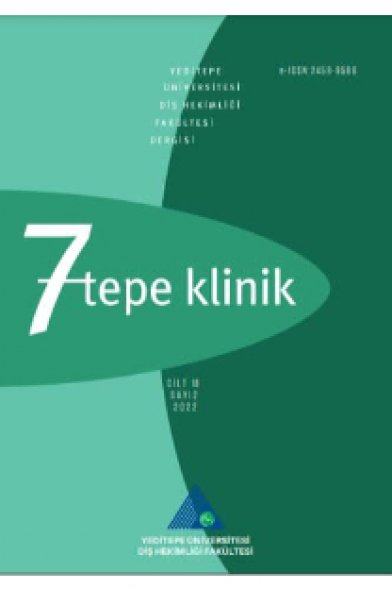Hareketli ortodontik apareyler ile ilgili youtube™ videolarının içerik analizi
Youtube™ video content analysis on removable orthodontic appliance
___
- 1. Topkara Ahu, Sarı Zafer. Ortodontik tedavilerde kullanılan hareketli aparey tipleri. SÜ Diş Hek Fak Derg 2009; 18: 74-77.
- 2. Kerr W J S, McColl J H, Frostick L. The use of removable orthodontic appliances in the General Dental Service. Br Dent J 1996; 181: 18-22.
- 3. Roberts-Harry D, Sandy J. Orthodontics. Part 5: Appliance choices, Br Dent J 2004; 196: 9-18.
- 4. Littlewood SJ, Tait AG, Mandal NA, Lewis DH. The role of removable appliances in contemporary orthodontics, Br Dent J 2001; 191: 304-310.
- 5. Proffit WR. Fixed and Removable appliances, Contemporary Orthodontics;2nd ed, St. Louis, Mosby-Year Book Inc,; 1993.
- 6. AlGhamdi KM, Moussa NA. Internet use by the public to search for health-related information. Int J Med Inf 2012; 81: 363-373.
- 7. Noll D, Mahon B, Shroff B, Carrico C, Lindauer SJ. Twitter analysis of the orthodontic patient experience with braces vs Invisalign. Angle Orthod 2016; 87: 377-383.
- 8. Madathil KC, Rivera-Rodriguez AJ, Greenstein JS, Gramopadhye AK. Healthcare information on YouTube: a systematic review. Health Informs J 2015; 21: 173-194.
- 9. Greene JA, Choudhry NK, Kilabuk E, Shrank WH. Online social networking by patients with diabetes: a qualitative evaluation of communication with Facebook. J Gen Intern Med 2011; 26: 287-292.
- 10. De Boer MJ, Versteegen GJ, Van Wijhe M. Patients’ use of the Internet for pain-related medical information. Patien Educ Coun 2007; 68: 86-97.
- 11. Youtube.com’s global traffic rank. (https://www.alexa. com/siteinfo/youtube.com)
- 12. Omnicoreagency.com. YouTube Statistics.(https:// www.omnicoreagency.com/youtube-statistics/ )
- 13. Al-Silwadi FM, Gill DS, Petrie A, Cunningham SJ. Effect of social media in improving knowledge among patients having fixed appliance orthodontic treatment: a single-center randomized controlled trial. Am J Orthod Dentofacial Orthop 2015; 148: 231-237.
- 14. ElKarmi R, Hassona Y, Taimeh D, Scully C. YouTube as a source for parents’ education on early childhood caries. Int J Paediatr Dent 2017; 27: 437-443.
- 15. Hansen C, Interrante JD, Ailes EC, Frey MT, Broussard CS, et al. Assessment of YouTube videos as a source of information on medication use in pregnancy. Pharmacoepidem Drug Safety 2016; 25: 35-44.
- 16. Basch CH, Kecojevic A, Berdnik A, Cadorett V, Basch CE. An analysis of widely viewed youtube videos on anal cancer. Int J Prevent Med 2017; 8.
- 17. Lena Y, Dindaroğlu F. Lingual orthodontic treatment: A YouTube™ video analysis. Angle Orthod 2017; 88: 208- 214.
- 18. Desai T, Shariff A, Dhingra V, Minhas D, Eure M, Kats M. Is content really king? An objective analysis of the public's response to medical videos on YouTube. PLoS One 2013; 8: e82469.
- 19. Rachel HM, Margaret Knight A, Morgaine KS, Antoun J, Farella MA. qualitative analysis of orthodontic-related posts on Twitter. Angle Orthod 2013; 84: 203-207.
- 20. Nason K, Donnelly A, Duncan H. YouTube as a patient‐information source for root canal treatment. Int Endod J 2016; 49: 1194-1200.
- 21. Pandey A, Patni N, Singh M, Sood A, Singh G. YouTube as a source of information on the H1N1 influenza pandemic. Am J Prev Med 2010; 38: e1-e3.
- 22. Nason GJ, Kelly P, Kelly ME, Burke MJ, Aslam A, Giri SK, et al. YouTube as an educational tool regarding male urethral catheterization. Scand J Urol Nephrol 2015; 49: 189-192.
- 23. Knösel M, Jung K. Informational value and bias of videos related to orthodontics screened on a video-sharing Web site. Angle Orthod 2011; 81: 532-539.
- 24. American Association of Orthodontists. Clinical Practice Guidelines Orthodontics and Dentofacial Orthopedics 2008. (https://www.aaoinfo.org/system/files/media/documents/2014%20Cllinical%20Practice%20Guidelines.pdf)
- 25. Boston M, Ruwe E, Duggins A, Willging JP. Internet use by parents of children undergoing outpatient otolaryngology procedures. Arch Otolaryngol Head Neck Surg 2005; 131: 719-722.
- 26. Singh AG, Singh S, Singh PP. YouTube for information on rheumatoid arthritis-a wakeup call? J Rheumatol 2012; 111: 114.
- 27. Beall Iii MS, Golladay GJ, Greenfield MLV, Hensinger RN, Biermann JS. Use of the Internet by pediatric orthopaedic outpatients. J Pediatr Orthop 2002; 22: 261-264.
- 28. Wainstein BK, Sterling‐Levis K, Baker SA, Taitz J, Brydon M. Use of the Internet by parents of paediatric patients. J Paediatr Child Health 2006; 42: 528-532.
- 29. Bezner SK, Hodgman EI, Diesen DL, Clayton JT, Minkes RK, Langer JC, et al. Pediatric surgery on YouTube™: Is the truth out there? J Pediatr Surg 2014; 49: 586-589.
- ISSN: 2458-9586
- Yayın Aralığı: Yılda 3 Sayı
- Başlangıç: 2005
- Yayıncı: Yeditepe Üniversitesi Rektörlüğü
Sella tursika köprülenmesi ile maksiller darlık arasındaki ilişkinin araştırılması
ERKUT KAHRAMANOĞLU, Zeliha ŞANIVAR ABBASGHOLİZADEH, Seçil ÖZKAN, Yasemin KULAK ÖZKAN
Özge DOĞANAY, SEZEN ATASOY, Nurettin DİKER, Alper ALKAN
Cansu GÖRÜRGÖZ, Nur HACIOSMANOĞLU, Bengi ÖZTAŞ
Hareketli ortodontik apareyler ile ilgili youtube™ videolarının içerik analizi
Obezite-periodontal hastalık ilişkisi ve rol oynayan olası mekanizmalar
Vesile Elif TOY, SERKAN DÜNDAR
Gıdaları taklit eden solüsyonların bulk-fill kompozitlerin renklenmesine etkisi
Özge Gizem CABADAĞ, Nihan GÖNÜLO, Lena ALMASİFAR, Tuğba MİSİLLİ
Elif OK, Ali̇ TAGHİZADEHGHALEHJOUGHİ, Hakan KAMALAK
Hastaların dental implant farkındalıklarının ve bilgi düzeylerinin araştırılması
Dilek MENZİLETOĞLU, Ali KILINÇ, Bozkurt Kubilay IŞIK, Ceyda AKIN
